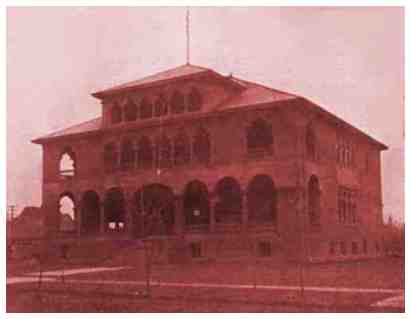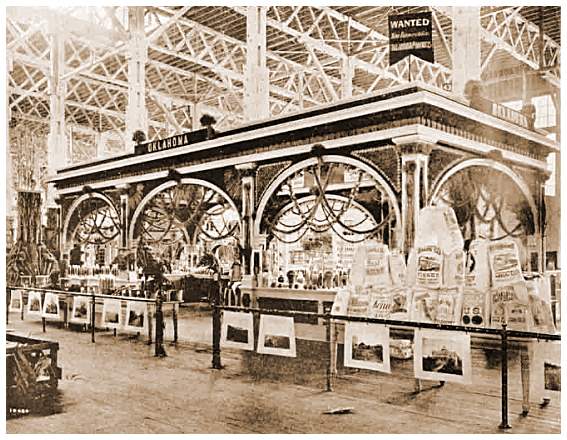Oklahoma's entry was a Spanish style with a semi-Moorish-influenced red roof that was two stories high. The 76 by 70 foot building that cost 15,420 dollars. The front of the building was surrounded by two big verandas, in the cloistered recesses porches could be found all sorts of chairs to rest the weary fairgoer. It sat next to the New York building.
Oklahoma cement was used in its exterior fabrication.
Inside, its fourteen rooms included, a large reception hall with fine wood finishings separated two parlors. The men's parlor contained a 12 foot table made from a single piece of wood. Displays of art and history included a series of portraits of the five Governors of the territory. A few tables dated back to the era of Napoleon.
All the plaster, inside and out, used in the construction of the building was manufactured from Oklahoma gypsum.
A register was kept for the signatures of visitors.
Open to the public was a 600-seat restaurant.
It was dedicated May 23, 1904.
Oklahoma Territory displayed noted products in the Palaces of Agriculture, and Mines.
They also had a large exhibit in the Palace of Education; its 488 square feet contained representative work from the kindergarten to the University of Oklahoma. All the seven colleges and preparatory schools supported by the territory were represented, and many of the ten institutions of higher learning supported by denominational and private enterprises.
In the Horticultural Department the exhibit covered 1,100 square feet of floor space. The exhibit consisted of 250 jars of preserved fruits of
the various kinds produced in Oklahoma Territory, 200 bottles of Oklahoma grape wine, and about 400 plates of fresh fruits of the various kinds in their season. Four hundred and fifty bushels of the choicest apples were placed in cold storage in the fall of 1903 to keep the exhibit fresh.
The state's mineral exhibit occupied 1,020 square feet in the Palace of Mines and Metallurgy. Here were shown 186 exhibits of sandstone, limestone, and other building stone, magnetite, brick (both burned and green), transparent selenite, and various others from Oklahoma Territory. It also contained salt, oil, and glass sand testing 96 per cent pure.
After the Fair, the Oklahoma building lodge was cut into sections and loaded onto a Rock Island train bound for El Reno. Rock Island Elks officials lobbied for the building to be reassembled in El Reno, their hometown and it was opened in 1905. The building's second floor contained a balcony, which was later sealed because of pigeon problems. The basement and stage area was added later.
Many still marvel at its engineering, as the edifice appears seamless.





